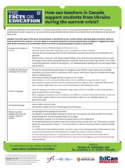How can teachers in Canada support students from Ukraine during the current crisis?
Canada has responded to the recent invasion of Ukraine by welcoming a small minority of displaced people from Ukraine. When displaced students enter Canadian classrooms, many assumptions, biases and prescriptions about how to receive them could complicate these students’ experiences.
Refugees from other parts of the world have continued to be affected by war, conflict, famine, and other global atrocities. While we focus on children from Ukraine in this fact sheet, it is crucial for educators to also be mindful about the plight of refugees from other parts of the world and to be careful about how the narrative of displaced people in Canada is constructed.
|
Be aware of the layers of trauma
|
- The Russian invasion of Ukraine began on February 20, 2014.
- Ukrainian children have been traumatized and re-traumatized for almost a decade.
- Ukraine’s history includes centuries of Russian imperialism, attempts at assimilation and colonization, and genocide.
- Aside from fear, worry, and other trauma-related feelings, some Ukrainians also experience shame and guilt for having survived, and/or having left loved ones, especially males of conscription age, behind. School-wide trauma-informed social-emotional learning (SEL), and restorative justice teaching practices will support these and all children.
|
| Consider the experiences of families from Ukraine |
- Through the Canada-Ukraine authorization for emergency travel (CUAET), most Ukrainians are in Canada temporarily (up to three years) to work/study until it is safe to return home. They do not benefit from refugee status or related services.
- Government-provided language learning for parents is non-existent.
- Some children are still accessing Ukrainian online school, in addition to being schooled in Canada.
- Some Ukrainian parents consider Ukrainian education to be more rigorous. That, coupled with their limited stay in Canada, might make them more reticent to advocate for their child(ren)’s needs.
|
| A note on language |
- Ukrainian language and culture were banned for long periods of time in the USSR. As such, many Ukrainians speak Russian as their mother tongue.
- Slavic languages, including Ukrainian and Russian, use different variations of the Cyrillic alphabet. In learning French and/or English, children from Ukraine will also have to learn the Latin alphabet, sounds, and grammatical rules.
|
| Use factual language |
- Avoid: conflict, situation, issue.
- Use: Russian invasion of Ukraine, Russian genocide of Ukrainians.
|
| What to say when students ask about the Russian invasion of Ukraine |
- Use age-appropriate language and responses.
- Pay attention to how the student is feeling (it is OK to ask “How does this war make you feel?” and to listen empathetically and respond compassionately and factually).
- Most important, however, is to not attempt to explain what you don’t understand.
- For younger (primary) level students, keep it very simple, factual, and stay calm, e.g. “The people in charge in Russia are hurting people in Ukraine.” It is also appropriate to redirect very young children away from further discussion.
- For middle school (intermediate) students, discussion might involve sharing examples of historical facts (see resources below) and inviting students to consider how people in Ukraine are feeling.
- For older (secondary) students, it is appropriate to explore what they know about the invasion and to intentionally redirect and name misinformation that could reinforce messages of hate or discrimination (see resources below).
|
Meet the Expert(s)
Tamara A Bolotenko
VP of Citizenship, TFS - Canada's International School
Tamara Bolotenko (OCT, MT) is Vice-Principal of Citizenship for Grade 6 and 7 at TFS –Canada’s International School. She has taught, learned and lived in Ukraine, the U.A.E., New Zealand, and Kazakhstan.
Read More
Dr. Crystena A. H. Parker-Shandal
Associate Professor, University of Waterloo
Crystena Parker-Shandal (OCT, PhD) is an Associate Professor at the University of Waterloo. She is the co-editor of Finding Refuge in Canada: Narratives of dislocation and co-founder of the Refugee Storybank of Canada. www.drparkershandal.com
Read More

